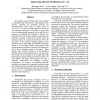Free Online Productivity Tools
i2Speak
i2Symbol
i2OCR
iTex2Img
iWeb2Print
iWeb2Shot
i2Type
iPdf2Split
iPdf2Merge
i2Bopomofo
i2Arabic
i2Style
i2Image
i2PDF
iLatex2Rtf
Sci2ools
CSB
2005
IEEE
2005
IEEE
Improving Operon Prediction in E. coli
In bacterium, genes working in the same pathway or interacting with each other are often organized into operons. Currently, the prediction accuracy for operon/boundary gene pairs is fairly good in Escherichia coli, however, such a high level of success in recognizing a gene pair as a boundary or operon pair does not automatically transcribe into a high level of accuracy in predicting the boundary of operons. We found that for several operon prediction programs, the prediction accuracy is often less accurate when the intergenic region of a gene pair is between 40 to 250 base pairs. In our approach, multiple features of the intergenic region, gene length and available microarray data in E. coli were used to improve the accuracy of the operon prediction programs in general and of gene pairs in the above intergenic region in particular. These features were scored according to a log likelihood formula, and the result suggests that we can gain up to 8% increase in the accuracy level for gen...
| Added | 24 Jun 2010 |
| Updated | 24 Jun 2010 |
| Type | Conference |
| Year | 2005 |
| Where | CSB |
| Authors | PhuongAn Dam, Victor Olman, Ying Xu |
Comments (0)

